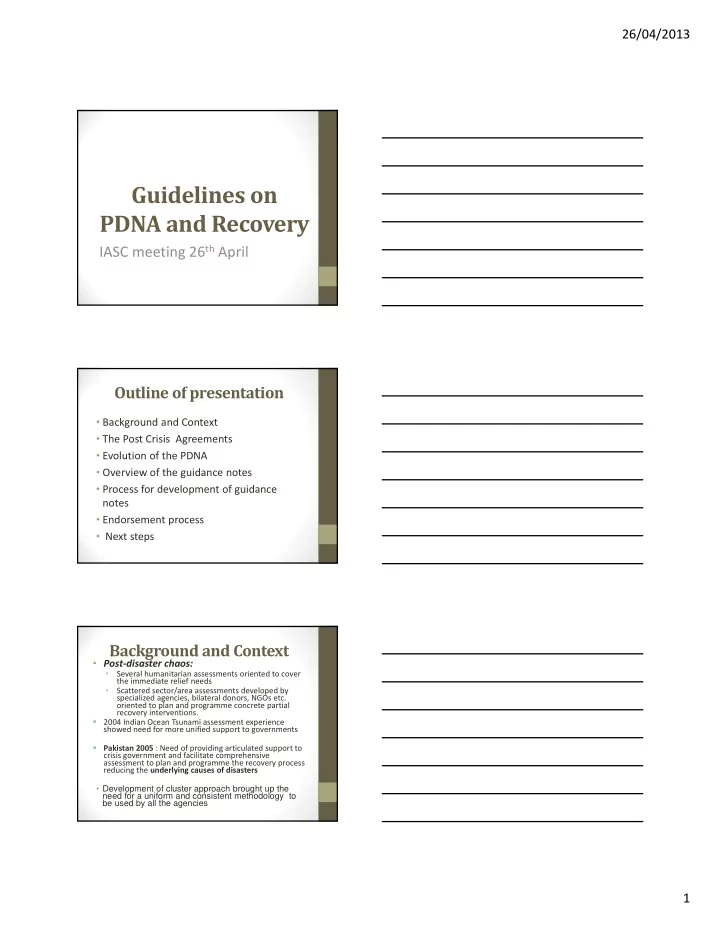

26/04/2013 Guidelines on PDNA and Recovery IASC meeting 26 th April Outline of presentation • Background and Context • The Post Crisis Agreements • Evolution of the PDNA • Overview of the guidance notes • Process for development of guidance notes • Endorsement process • Next steps Background and Context • Post ‐ disaster chaos: • Several humanitarian assessments oriented to cover the immediate relief needs • Scattered sector/area assessments developed by specialized agencies, bilateral donors, NGOs etc. oriented to plan and programme concrete partial recovery interventions. � 2004 Indian Ocean Tsunami assessment experience showed need for more unified support to governments � Pakistan 2005 : Need of providing articulated support to crisis government and facilitate comprehensive assessment to plan and programme the recovery process reducing the underlying causes of disasters • Development of cluster approach brought up the need for a uniform and consistent methodology to be used by all the agencies 1
26/04/2013 Post Crisis : Agreements and principles • Joint Declaration on Post ‐ Crisis Assessments and Recovery Planning (UNDG – World Bank and EC) signed 25 September 2008 � Common platform for partnership and action” � “Collaboration to enhance country resilience to crisis ” � “ integrated efforts to work with national authorities and partners to strengthen national capacity for effective prevention and response ”; � “Support implementation of national recovery” � “Need to be flexible to respond to different country needs” � Common methodology, toolkit and capacities Evolution of the PDNA • PDNA evolved from the Damage and Loss Assessment (DALA) Methodology developed by the Economic Commission for Latin America and the Caribbean (ECLAC) in early 1970s. • Sector ‐ based analysis largely focused on infrastructure losses: roads, communication, power, public buildings, etc and aggregation of sector ‐ wise results to ascertain the cumulative impact of a disaster. • Damage represented total or partial destruction of physical assets, which occurs during the disaster event itself, and valued at replacement costs Evolution of PDNA : From Dala to HRNA • The HRNA evolved from the need to expand definitions of assessment from valuation of physical damages and economic losses to capture impacts on human development including impacts on households and communities, on social, cultural and governance issues. • It also aims to shift focus from economic recovery to broader restoration of functions and systems and capacities. • Need to capture impact across households and communities , going beyond economic losses to social and cultural loss. • Focus on vulnerable, excluded, marginalized groups and on cross cutting issues such as gender, risks and environment. 2
26/04/2013 Overview of the guidance notes • Volume B 12 guidance Volume A notes • Introduction to the • Education , Health , PDNA Housing, Culture • Assessment • Agri; Fish &Livestock approach (Dala & Empl & livelihoods HRNA) • WASH & Community • Procedures and infrastructure tools • DRR , Governance , Gender , Environment. Overview of guidance notes : Volume A Chapters 1 & 2 Chap 3 Procedures • Introduction • Process for activating , • Defines the key elements and conducting a PDNA. of the Assessment • Protocols for process coordinated support by • Outlines key steps to the the partners assessment from data • Addresses critical issues collection to analysis and such as timing of the guidance for the development of a assessment , role of the Recovery Roadmap based 3 partners vis a vis the on the assessment National Government results. Overview of Guidance notes Volume B • The sector chapters follow a common structure that captures the core elements of the PDNA approach described in Volume A . • While the sectors follow this broad structure, each sector has its own set of tools, techniques and assessment methodologies developed by the specialized UN agencies and Bank pertinent to the needs of the particular sector. • Introduction of new sectors : WASH , DRR, Community Infrastructure , Governance more focus on specific niche areas and as cross cutting issues. 3
26/04/2013 Process for development of Guidance notes • Started in 2010 with nine UN agencies working on the chapters • UNDP took the lead in developing the overall chapeau chapter which outlines the assessment approach and the procedures for conducting the PDNA. • UNICEF, UNEP, UN ‐ Habitat, UNESCO, UN Women, ILO, FAO, WHO, UNDP drafted the sector chapters • Drafting team for both Volume A and Volume B included team of experts with years of experience in conducting both humanitarian assessments and PDNAs. • Two iterations , first in 2011 and the second in 2012 with the Human Recovery needs assessment approach integrated in all sector chapters . Process of Consultation • Three levels of consultations : In house; Technical experts UN system & Key partners. • 2011 online consultations on the guidance notes by uploading the documents on IRP workspace exclusively dedicated to PDNAs with experts given access to comment on the notes • 2012 : Technical review of the sector guidance notes by Cluster working groups , other UN agencies , Donors agencies. • Bilateral consultations with experts in the Bank and EU. Endorsement Process Why • Meeting one key milestone of the partnership: to develop common methodological guidelines • “Binds” three partners to observe ‘rules of engagement” work together in support of National Governments • Establishes standard and methodology for assessment. • Facilitates institutionalization and capacity building in countries. • Important for public dissemination and use by practitioners 4
26/04/2013 Next Steps • Endorsement by EU and the World Bank first on Volume A and subsequently on Volume B • Launch in the Global Platform for DRR by the three partners • Developing of training materials and capacity building activities • Strengthen linkages between MIRA and PDNA Discussion & Questions THANK YOU 5
Recommend
More recommend